流的概念
在Java中,流是从源到目的地的字节的有序序列。Java中有两种基本的流——输入流(InputStream)和输出流(OutputStream)。
根据流相对于程序的另一个端点的不同,分为节点流和过滤流。
- 节点流:以特定源如磁盘文件、内存某区域或者线程之间的管道为端点的构造输入输出流,是一种基本的流。
- 过滤流:以其他已经存在的流为端点构造的输入输出流。
根据流中的数据单位分为字节流和字符流。
- 字节流:流中的数据是以8位字节为单位进行读写,以InputStream和OutputStream为基础类。
- 字符流:流中的数据是以16为字符为单位进行读写,以Reader和Writer为基础类。
Java.IO层次体系结构
Java.io是大多数面向数据流的输入/输出类的主要软件包。此外,Java也对块传输提供支持,在核心库 java.nio中采用的便是块IO。
流IO的好处是简单易用,缺点是效率较低。块IO效率很高,但编程比较复杂。
在整个Java.io包中最重要的就是5个类和一个接口。5个类指的是File、OutputStream、InputStream、Writer、Reader;一个接口指的是Serializable。掌握了这些IO的核心操作那么对于Java中的IO体系也就有了一个初步的认识了。
Java I/O主要包括如下几个层次,包含三个部分:
- 流式部分――IO的主体部分;
- 非流式部分――主要包含一些辅助流式部分的类,如:File类、RandomAccessFile类和FileDescriptor等类;
- 其他类――文件读取部分的与安全相关的类,如:SerializablePermission类,以及与本地操作系统相关的文件系统的类,如:FileSystem类和Win32FileSystem类和WinNTFileSystem类。
主要的类如下:
- File(文件特征与管理):用于文件或者目录的描述信息,例如生成新目录,修改文件名,删除文件,判断文件所在路径等。
- InputStream(二进制格式操作):抽象类,基于字节的输入操作,是所有输入流的父类。定义了所有输入流都具有的共同特征。
- OutputStream(二进制格式操作):抽象类,基于字节的输出操作,是所有输出流的父类。定义了所有输出流都具有的共同特征。
- Reader(文件格式操作):抽象类,基于字符的输入操作。
- Writer(文件格式操作):抽象类,基于字符的输出操作。
- RandomAccessFile(随机文件操作):它的功能丰富,可以从文件的任意位置进行存取(输入输出)操作。
Java中IO流的体系结构如图:

Java.IO流类库
java.io包中包含了流式I/O所需要的所有类。在java.io包中有四个基本类:InputStream、OutputStream及Reader、Writer类,它们分别处理字节流和字符流:
|
输入/输出 |
字节流 |
字符流 |
|
输入流 |
Inputstream |
Reader |
|
输出流 |
OutputStream |
Writer |
JDK1.4版本开始引入了新I/O类库,它位于java.nio包中,新I/O类库利用通道和缓冲区等来提高I/O操作的效率。
在java.io包中,java.io.InputStream表示字节输入流,java.io.OutputStream表示字节输出流,处于java.io包最顶层。这两个类均为抽象类,也就是说它们不能被实例化,必须生成子类之后才能实现一定的功能。
字节流
InputStream抽象类
InputStream 为字节输入流,它本身为一个抽象类,必须依靠其子类实现各种功能,此抽象类是表示字节输入流的所有类的超类。 继承自InputStream的流都是向程序中输入数据的,且数据单位为字节(8bit);
InputStream是输入字节数据用的类,所以InputStream类提供了3种重载的read方法.Inputstream类中的常用方法:
- public abstract int read( ):读取一个byte的数据,返回值是高位补0的int类型值。若返回值=-1说明没有读取到任何字节读取工作结束。
- public int read(byte b[ ]):读取b.length个字节的数据放到b数组中。返回值是读取的字节数。该方法实际上是调用下一个方法实现的。
- public int read(byte b[ ], int off, int len):从输入流中最多读取len个字节的数据,存放到偏移量为off的b数组中。
- public int available( ):返回输入流中可以读取的字节数。注意:若输入阻塞,当前线程将被挂起,如果InputStream对象调用这个方法的话,它只会返回0,这个方法必须由继承InputStream类的子类对象调用才有用。
- public long skip(long n):忽略输入流中的n个字节,返回值是实际忽略的字节数, 跳过一些字节来读取 。
- public int close( ) :我们在使用完后,必须对我们打开的流进行关闭。
主要的子类:
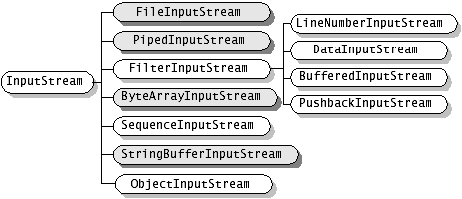
- FileInputStream:把一个文件作为InputStream,实现对文件的读取操作;
- ByteArrayInputStream:把内存中的一个缓冲区作为InputStream使用;
- StringBufferInputStream:把一个String对象作为InputStream;
- PipedInputStream:实现了pipe的概念,主要在线程中使用;
- SequenceInputStream:把多个InputStream合并为一个InputStream 。
OutputStream抽象类
OutputStream提供了3个write方法来做数据的输出,这个是和InputStream是相对应的。
- public void write(byte b[ ]):将参数b中的字节写到输出流。
- public void write(byte b[ ], int off, int len) :将参数b的从偏移量off开始的len个字节写到输出流。
- public abstract void write(int b) :先将int转换为byte类型,把低字节写入到输出流中。
- public void flush( ) : 将数据缓冲区中数据全部输出,并清空缓冲区。
- public void close( ) : 关闭输出流并释放与流相关的系统资源。
主要的子类:

- ByteArrayOutputStream:把信息存入内存中的一个缓冲区中
- FileOutputStream:把信息存入文件中
- PipedOutputStream:实现了pipe的概念,主要在线程中使用
- SequenceOutputStream:把多个OutStream合并为一个OutStream
流结束的判断:方法read()的返回值为-1时;readLine()的返回值为null时。
文件输入流FileInputStream类
FileInputStream可以使用read()方法一次读入一个字节,并以int类型返回,或者是使用read()方法时读入至一个byte数组,byte数组的元素有多少个,就读入多少个字节。在将整个文件读取完成或写入完毕的过程中,这么一个byte数组通常被当作缓冲区,因为这么一个byte数组通常扮演承接数据的中间角色。

作用:以文件作为数据输入源的数据流。或者说是打开文件,从文件读数据到内存的类。
使用方法(1):
File fin=new File("d:/abc.txt"); FileInputStream in=new FileInputStream(fin);
使用方法(2):
FileInputStream in=new FileInputStream(“d:/abc.txt”);

package IO; import java.io.FileInputStream; import java.io.IOException; /** * 文件输入流:FileInputStream类 * @author Administrator * */ public class TestFile2 { public static void main(String[] args) { try { FileInputStream rf = new FileInputStream("E:\test\io.txt"); int n = 512; byte buffer[] = new byte[n]; while ((rf.read(buffer, 0, n) != -1) && (n > 0)) { System.out.println(new String(buffer)); } rf.close(); } catch (IOException IOe) { System.out.println(IOe.toString()); } } }
文件输出流FileOutputStream类
作用:用来处理以文件作为数据输出目的数据流;或者说是从内存区读数据写入文件。
FileOutputStream类用来处理以文件作为数据输出目的数据流;一个表示文件名的字符串,也可以是File或FileDescriptor对象。
创建一个文件输出流对象有四种方法:
方式1:
File f=new File (“d:/myjava/write.txt "); FileOutputStream out= new FileOutputStream (f);
方式2:
FileOutputStream out=new FileOutputStream(“d:/myjava/write.txt ");
方式3:构造函数将FileDescriptor()对象作为其参数。
FileDescriptor() fd=new FileDescriptor(); FileOutputStream f2=new FileOutputStream(fd);
方式4:构造函数将文件名作为其第一参数,将布尔值作为第二参数。
FileOutputStream f=new FileOutputStream("d:/abc.txt",true);
注意:
- 文件中写数据时,若文件已经存在,则覆盖存在的文件;
- 读/写操作结束时,应调用close方法关闭流。

package IO; import java.io.FileOutputStream; import java.io.IOException; /** * 文件输出流:FileOutputStream类 * @author Administrator * */ public class TestFile3 { public static void main(String args[]) throws IOException { try { System.out.println("请输入:"); int count, n = 512; byte buffer[] = new byte[n]; count = System.in.read(buffer); FileOutputStream wf = new FileOutputStream("e:/test/io.txt"); wf.write(buffer, 0, count); wf.close(); // 当流写操作结束时,调用close方法关闭流。 System.out.println("Save to the write.txt"); } catch (IOException IOe) { System.out.println("File Write Error!"); } } }
缓冲输入输出流 BufferedInputStream/ BufferedOutputStream
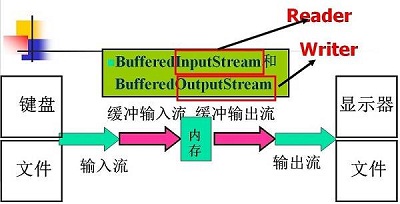
计算机访问外部设备非常耗时。访问外存的频率越高,造成CPU闲置的概率就越大。为了减少访问外存的次数,应该在一次对外设的访问中,读写更多的数据。为此,除了程序和流节点间交换数据必需的读写机制外,还应该增加缓冲机制。缓冲流就是每一个数据流分配一个缓冲区,一个缓冲区就是一个临时存储数据的内存。这样可以减少访问硬盘的次数,提高传输效率。
- BufferedInputStream:当向缓冲流写入数据时候,数据先写到缓冲区,待缓冲区写满后,系统一次性将数据发送给输出设备。
- BufferedOutputStream :当从向缓冲流读取数据时候,系统先从缓冲区读出数据,待缓冲区为空时,系统再从输入设备读取数据到缓冲区。
将文件读入内存:将BufferedInputStream与FileInputStream相接
FileInputStream in=new FileInputStream(“file1.txt”); BufferedInputStream bin=new BufferedInputStream(in);
将内存写入文件:将BufferedOutputStream与 FileOutputStream相接
FileOutputStreamout=new FileOutputStream(“file1.txt”); BufferedOutputStream bin=new BufferedInputStream(out);
字符流Writer/Reader
Java中字符是采用Unicode标准,一个字符是16位,即一个字符使用两个字节来表示。为此,JAVA中引入了处理字符的流。
Reader抽象类
用于读取字符流的抽象类。子类必须实现的方法只有read(char[], int, int) 和 close()。但是,多数子类将重写此处定义的一些方法,以提供更高的效率和/或其他功能。
主要方法:
public int read() throws IOException; //读取一个字符,返回值为读取的字符 public int read(char cbuf[]) throws IOException; /*读取一系列字符到数组cbuf[]中,返回值为实际读取的字符的数量*/ public abstract int read(char cbuf[],int off,int len) throws IOException; /*读取len个字符,从数组cbuf[]的下标off处开始存放,返回值为实际读取的字符数量,该方法必须由子类实现*/
主要的子类:
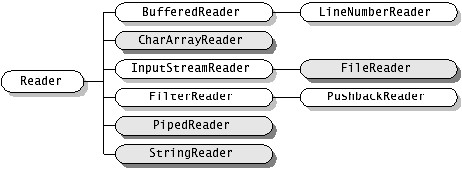
FileReader :与FileInputStream对应,主要用来读取字符文件,使用缺省的字符编码
CharArrayReader:与ByteArrayInputStream对应
- 用指定字符数组作为参数:CharArrayReader(char[])
- 将字符数组作为输入流:CharArrayReader(char[], int, int)
StringReader : 与StringBufferInputStream对应
InputStreamReader :从输入流读取字节,在将它们转换成字符
FilterReader: 允许过滤字符流
BufferReader :接受Reader对象作为参数,并对其添加字符缓冲器,使用readline()方法可以读取一行。
Writer抽象类
写入字符流的抽象类。子类必须实现的方法仅有write(char[], int, int)、flush() 和 close()。但是,多数子类将重写此处定义的一些方法,以提供更高的效率和/或其他功能。
主要方法:
public void write(int c) throws IOException;//将整型值c的低16位写入输出流 public void write(char cbuf[]) throws IOException;//将字符数组cbuf[]写入输出流 public abstract void write(char cbuf[],int off,int len) throws IOException;//将字符数组cbuf[]中的从索引为off的位置处开始的len个字符写入输出流 public void write(String str) throws IOException;//将字符串str中的字符写入输出流 public void write(String str,int off,int len) throws IOException;//将字符串str 中从索引off开始处的len个字符写入输出流 flush( ); //刷空输出流,并输出所有被缓存的字节 close(); //关闭流 public abstract void close() throws IOException
其子类如下:
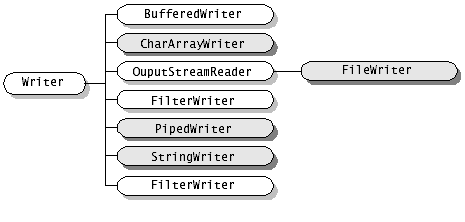
FileWrite: 与FileOutputStream对应 ,将字符类型数据写入文件,使用缺省字符编码和缓冲器大小。
CharArrayWrite:与ByteArrayOutputStream对应 ,将字符缓冲器用作输出。
PrintWrite:生成格式化输出
FilterWriter:用于写入过滤字符流
PipedWriter:与PipedOutputStream对应
StringWriter:无与之对应的以字节为导向的stream
InputStream与Reader差别, OutputStream与Writer差别
InputStream和OutputStream类处理的是字节流,数据流中的最小单位是字节(8个bit)
Reader与Writer处理的是字符流(16个bit),在处理字符流时涉及了字符编码的转换问题。
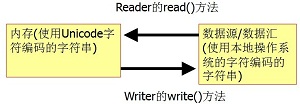
Reader类能够将输入流中采用其他编码类型的字符转换为Unicode字符,然后在内存中为其分配内存
Writer类能够将内存中的Unicode字符转换为其他编码类型的字符,再写到输出流中。
Java中流的关闭
代码中关闭流,一般可以在finally中关闭 :
File file = new File("D:" + File.separator + "test.txt"); InputStream in = null; try { in = new FileInputStream(file); // operation input stream // ... } catch (FileNotFoundException e) { e.printStackTrace(); } finally { // !!!这里如果要关闭的流很多,那么就会写出很多冗余且相似的代码 if (in != null) { try { in.close(); } catch (IOException e) { // ignore } } }
如果要关闭的流很多,那么就会写出很多冗余且相似的代码,所以,需要编写方法去统一处理关闭流。
方法1:自行编码实现
可以把这个方法放到工具类中。但是本着不要重复造轮子的想法, 应该有工具类已经实现了这个方法。
private void close(Closeable closeable) { if (closeable != null) { try { closeable.close(); } catch (IOException e) { // ignore } } }
方法2:使用commons-io的IOUtils
Maven坐标:
<dependency> <groupId>commons-io</groupId> <artifactId>commons-io</artifactId> <version>2.6</version> </dependency>
源代码:
/** * Unconditionally close a <code>Closeable</code>. * <p> * Equivalent to {@link Closeable#close()}, except any exceptions will be ignored. * This is typically used in finally blocks. * <p> * Example code: * <pre> * Closeable closeable = null; * try { * closeable = new FileReader("foo.txt"); * // process closeable * closeable.close(); * } catch (Exception e) { * // error handling * } finally { * IOUtils.closeQuietly(closeable); * } * </pre> * * @param closeable the object to close, may be null or already closed * @since Commons IO 2.0 */ public static void closeQuietly(Closeable closeable) { try { if (closeable != null) { closeable.close(); } } catch (IOException ioe) { // ignore } }
调用示例:
public static void main(String[] args) { File file = new File("D:" + File.separator + "test.txt"); InputStream in = null; try { in = new FileInputStream(file); // operation input stream // ... } catch (FileNotFoundException e) { e.printStackTrace(); } finally { IOUtils.closeQuietly(in); } }
方法3:try-with-resource (JDK1.7+)
在common-io-2.6版本中,这个IOUtils.closeQuietly(arg0);方法已经被弃用了,并且没有替代方案。
@Deprecated的说明如下:As of 2.6 removed without replacement. Please use the try-with-resources statement or handle suppressed exceptions manually.给我们的建议就是使用try-with-resources语句或者手动处理压制的异常。
try-with-resource这个语法糖是JDK1.7开始引入的,具体语法如下:
/** * auto closeable stream为实现自动关闭的Stream * JDK1.7 新增了一个java.lang.AutoCloseable接口,接口内部只有close()方法。 * JDK1.7 同时修改了java.io.Closeable接口,这个接口继承了AutoCloseable接口。 * 所以之前那些实现Closeable接口的stream都可以实现AutoCloseable接口中的自动关闭的功能。 */ try (auto closeable stream) { } catch (Exception e) { }
示例:
public static void main(String[] args) { File file = new File("D:" + File.separator + "test.txt"); try (InputStream in = new FileInputStream(file)) { // operation input stream // ... } catch (FileNotFoundException e) { // TODO Auto-generated catch block e.printStackTrace(); } catch (IOException e) { // ignore } }
参考:
